Heritage > Ballymoney Timeline
History of Borough of Ballymoney - Ballymoney Timeline
This time line is a summary of the history of the Borough of Ballymoney. The information will be expanded upon in the future and is only meant as an introduction to the rich story of this ancient region.
7,000-4,000BC Mesolithic Age - The hunter gatherers. Early settlers arrived in the Ballymoney area. They were enticed to the Causeway region by the rich resources available in the local landscape.
4,000-2,500BC Neolithic Age - The first farmers. People began to clear the dense forests to plant crops and keep livestock. Pottery was used for the first time and stone tools became more sophisticated. Huge stones were used to build tombs, the remains of which still survive at sites such as Dooey’s Cairn, Craigs Dolmen and the Broad Stone.
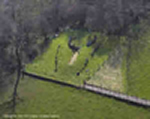

2,500-300BC Bronze Age - Metals used for the first time. Evidence of Bronze Age culture has been discovered at various sites in the Ballymoney area, including hoards found at Seacon More, Bootown, Drumbest and Drunkendalt. An ornate flesh hook was unearthed at Dunaverny and a remarkable Bronze Age willow ox yoke is held in the Ballymoney Museum.
300BC-400AD Iron Age - Among the Iron Age finds within the Borough of Ballymoney are a rare mirror handle found at Ballybogy and an ornately carved stone at Derrykeighan. The stone was engraved with a very early form of art and was discovered set into the wall of the ruined church at Derrykeighan.
400-1177AD Christians & Vikings - The church at Derrykeighan was established in 460AD by St. Colman. Early Christian communities soon spread throughout north Antrim. During this period, communities lived in raths, or ring forts, and the remnants of these sites can be found in abundance in the Ballymoney area e.g. Benvarden.

Early Christian art can be found on the Chi-Rho stone at Drumquern. In the tenth century, Vikings are thought to have begun sailing up the River Bann and raiding local settlements, taking slaves, treasure and crops.
941AD Prince Murtough McNeill from Aileach, near Derry, camped at Enagh Cross, near present day Ballymoney. His bard recorded that: "We were a night at Enagh Cross - Not more delightful to be in Paradise."

1177AD The Normans arrived in Co. Antrim. The remains of their fortified homes, known as motte & baileys, can be seen at sites such as Drumart and Knockahollet. Knockahollet
1300AD The first castle was built at Lissanoure. This estate later became the home of the Macartney family. Earl Macartney (1737-1806) was a highly successful diplomat and became the first British Ambassador to China.
1609AD King James I Plantation of Ulster began. Land was offered to settlers from England and Scotland who chose to come to Ulster. The English Crown had always found Ulster the most difficult region to control. James hoped that by ‘Planting’ Protestant families, Ireland would be ‘Anglicised’ and eventually conform to English rule.
1637AD The date stone in the Old Church Tower, Ballymoney, states that ‘THIS CHVRCH WAS BVLDED TO THE GLORYE OF GOD 1637’. Click here for the history of the Church Tower and the surrounding graveyard.
1642AD The town of Ballymoney, including the recently built church, were burned during the Irish Rebellion. The church was later rebuilt and survived as a place of worship until 1782.
During the Irish Rebellion, Scottish settlers in this region were attacked by Irish people who resented attempts to impose English rule, with strict new laws and the Protestant faith. Battles took place at the Leaney (just outside the present town of Ballymoney) and Portna (a ford near Rasharkin). A castle Cross, close to the River Bann was also attacked by Rebel Irish armies. The Rebellion failed and is remembered for the bloody atrocities committed by each side.
1689-1690AD At various times, the armies of both James II and William of Orange camped in the area as the campaign raged for the English Crown.
1737AD Birth of George, Earl of Macartney, at Lissanoure near Loughguile. Among his many positions, Macartney was the first British ambassador to China. Click here for more information on George Macartney of Lissanoure.
1764AD John Caldwell Snr. purchased Harvey’s Mill at Harmony Hill. This later became the site of Balnamore linen mill which employed thousands of local people until it closed in 1959.
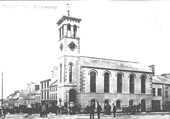
1775AD The original Ballymoney Town Hall was completed. Since then, it has served as a Town Hall, Market House, Courthouse, jail and is now the Masonic Hall.
The Original Town Hall building was completed in 1775AD
1777AD Ballymoney First Presbyterian Church completed, the oldest building still in use in the Borough.
1783 & 1784AD The Ballymoney Corps of the Irish Volunteers hosted ‘Reviews’ at Leslie Hill and are joined by other Volunteer Companies from across Co. Antrim and Co. Down. The Irish Volunteers were a self-financing citizen army that was established to defend Ireland against the threat of French invasion. Click here for further information on the Irish Volunteers.
1798AD Following the failed United Irish Rebellion, the town of Ballymoney was burned by Crown forces. The predominantly Presbyterian population of this region had supported the liberal objectives of the Rebel army and they suffered bloody retribution for their disloyalty. For further information, see 1798 United Irish Rebellion web pages.

1843AD Ballymoney Workhouse opened to help with the sick and poor from the region. Conditions in the workhouse were very difficult, with a strict region. For many it was the only option, as the hardship of famine swept throughout Ireland. The workhouse closed in 1918 and became the site of the now closed Route Hospital. Ballymoney Workhouse 1843-1918
1845AD Birth near Ballymoney of Robert Hannah. Hannah emigrated to New Zealand were he established the country's largest chain of shoe stores. His home, Antrim House in Wellington, is now the headquarters of the New Zealand Historic Places Trust. Click here to discover more about Robert Hannah.
1847AD Lissanoure Castle was blown up when barrels of gunpowder were accidentally ignited. Lady Macartney was killed instantly.
1850AD The streets of Ballymoney town are first lit by gas.
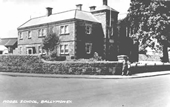
1856AD The Model School and Model Farm are opened. The Model School, now the site of the Causeway Institute
1860AD The first public museum was opened in the Borough. The artefacts were displayed in a room in the old Town Hall. Remnants of this collection can still be seen in the current Ballymoney Museum.
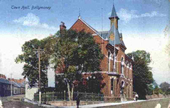
1866AD The current Ballymoney Town Hall was opened, almost entirely paid for by public subscription. Ballymoney Town Hall
1881AD The playwright George Shiels was born in Ballymoney. Shiels was the most popular Irish playwright of the mid twentieth century, his biggest successes including ‘The New Gossoon’, ‘Professor Tim’ and ‘The Rugged Path’. Shiels died in 1949.
Click here to discover more about the life of George Shiels.
1883AD In Ballymoney, the body of Alexander Gamble was discovered at the site of his execution. Gamble had been a United Irishman and was hanged in 1798 from the clock tower in the Diamond. He was reburied in the Old Church Graveyard.
Click here to discover more about Alexander Gamble.
1896AD William McKinley, whose ancestors came from Conagher, near Ballymoney, was elected 25th President of the America. McKinley was assassinated in 1901 during his second term as President.
1912AD Dervock born athlete K.K. McArthur won the Olympic Marathon. Although then living and competing as a South African citizen, McArthur never forgot his homeland. He claimed that he was spurred to victory on hearing a voice in the crowd shout “Come on Antrim, come on ye boy!”. Click here to discover more about K.K. McArthur.
1914-18AD Families from across the Borough suffered terrible grief as hundreds of young local men are sent to fight in World War One. Thanks to the research of historian Robert Thompson, the Ballymoney War Memorial lists their names. More information, including a full Roll of Honour, can also be found by clicking here.
1918AD Ulster comedian James Young born in Union Street, Ballymoney. Click here for more information on James Young.
1934AD After renovations, Ballymoney Town Hall re-opened and within weeks hosted the first ever Ballymoney Drama Festival. This annual event is the oldest provincial drama festival in Ireland and attracts huge audiences every year.
1939AD Another generation of young Ballymoney men and women were sent to fight a Second World War. Thanks to the research of historian Robert Thompson, the Ballymoney War Memorial lists their names.
1952AD Joey Dunlop MBE OBE, the most successful motorcycle racer of all time, was born. Joey had an outstanding sporting career and also performed remarkable humanitarian work abroad. He was tragically killed while racing in Estonia 2 July 2000. His funeral was attended by an estimated 20,000 people. Click here to discover more about Joey Dunlop MBE OBE.
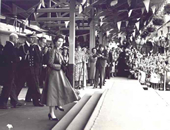
1953AD Queen Elizabeth II and the Duke of Edinburgh visited Ballymoney during the Coronation Tour. Queen Elizabeth II and the Duke of Edinburgh step off the train at Ballymoney Station
1956AD Soldiers from Ballymoney served in the Korean conflict in Asia.
1969AD The Troubles brought civil unrest, terrorism and thirty years of sorrow to the people of Northern Ireland.
1977AD Ballymoney is granted Borough status.
© Copyright 2010 Ballymoney Ancestry. Website Design by Redback Creations.


